When type 1 diabetes enters our lives, we have to re-learn how to do a lot of things. What we eat is no longer measured by the calorie count. We need to train our brains to focus on carb counting. Carbohydrates, something we’ve never paid much attention to on nutrition labels, are now the first thing (and sometimes the only thing) we look at. But what exactly are we looking for?
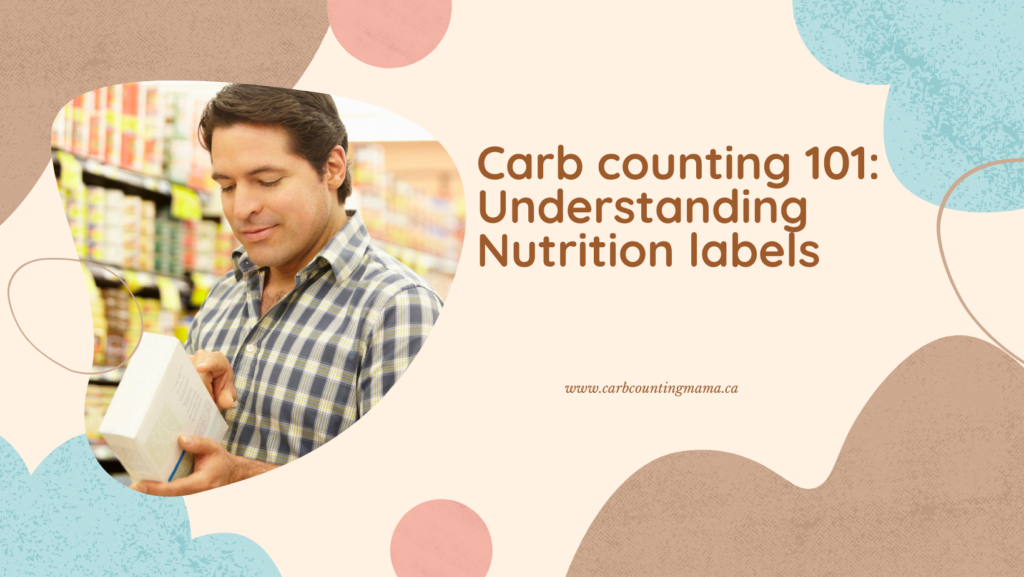
This post contains affiliate links
Most people will tell you that someone with type 1 diabetes can eat whatever they want, just as they did before they were diagnosed. This is true, but we now have to account for insulin doses. We have to count carbs to figure out how much insulin to give.
I never used to look at nutrition labels at all.
If you’re anything like me, you may not have been paying too much attention to things like calorie intake, sodium levels, or good fat vs. bad fat. I didn’t even really know what a carbohydrate was before my son was diagnosed with T1D.
All of a sudden, I had to start carb counting. It’s a tricky thing to get the hang of. Between Glycemic Index, the effect that fat and protein have on blood glucose levels, and the impact that activity has on insulin needs, it can feel like managing T1D is like trying to hit a moving target.
So, let’s start with the very basics… looking at nutritional labels.
Carb Counting with Nutrition Labels: The Basics
Alright, we need a number to use in that insulin-to-carb ratio. There are a lot of numbers on nutritional labels. When carb counting, there are two that are the most important to look at first:
- The portion size. Companies want their products to look healthy. That means they base the whole nutrition label on the calorie count. Snacks, in particular, will usually be around the 100-calorie mark. So sometimes, even if it’s an individual snack (like a chocolate bar), it may say “per 1/2 package”. Always make sure you know what the portion size is when using nutrition labels for carb counting.
- Carbohydrates, not sugars. You want to look at the number associated with “carbohydrates” or “total carbohydrates”. Lots of people associate diabetes with sugar, so some people automatically want to look at the sugar content. We’re not looking at the sugar content. At all. There’s no need to add it to anything. “Sugars” is already included in the “carbohydrate” count. Just ignore the sugar amount completely. Carbohydrates and sugars are often drastically different, so it can be dangerous to mix them up or add them together.
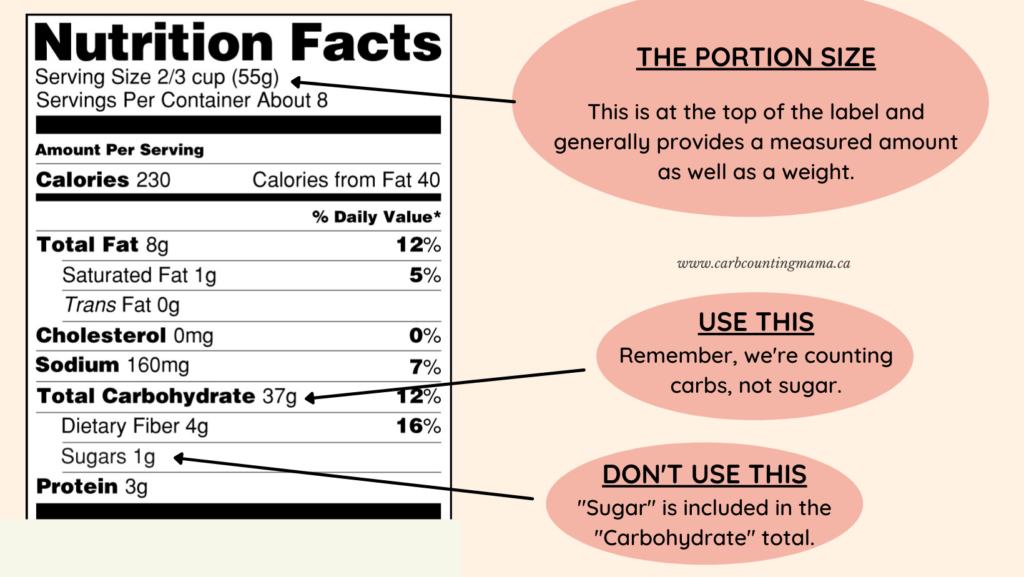
Carb Counting and Fiber
Fiber is an odd portion of the equation. Different diabetes teams teach different ways to deal with fiber.
There are four main ways people deal with fiber:
- Use total carbohydrate and don’t worry about fiber.
- Subtract the fiber from the total carbohydrate.
- If the fiber is more than 5g subtract it from the total carbohydrate.
- Subtract half the fiber if it’s more than 5g.
Fiber is not digestible like other carbohydrates. It does not break down into glucose, and therefore, should not require insulin. This implies that option #2 above is the one that is safest and will produce the best post-meal glucose numbers. That’s assuming your basal rate and carb ratios are accurate.
In most cases, it won’t make much of a difference whether or not you subtract fiber from total carbohydrate. With only a few grams of fiber in most items, the change in your insulin dose is negligible. So, if you don’t eat a high-fiber diet, option #1 probably won’t hurt. However, if you eat a meal with a significantly higher amount of fiber and dose for it as usual, you might end up dealing with low blood sugar numbers.
This is why some doctors suggest subtracting fiber when it’s over a certain amount (options 3 and 4). This makes some sense, but it’s inconsistent and easier to forget when you do eat a high-fiber meal. It’s much simpler for most people to subtract it all the time.
If what you’re doing doesn’t seem to be working for you, talk to your doctor about other options. Changing the way you count fiber may help your blood sugar numbers.
Sugar Alcohol
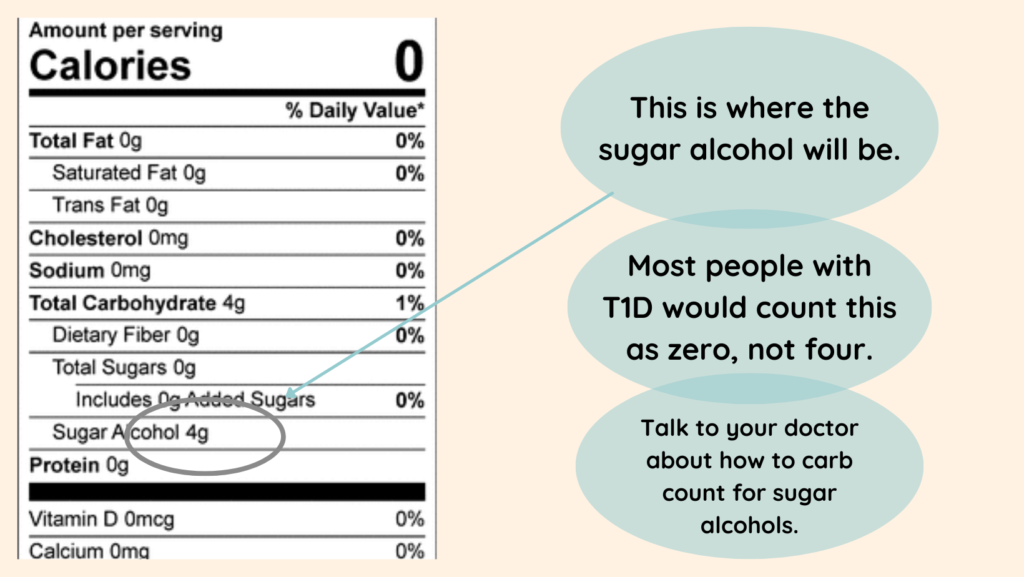
Sometimes, particularly in things like diabetic chocolate or candy, there is an extra line under the carbohydrate section called sugar alcohol.
Much like fiber, some people will subtract this and some will not.
Sugar alcohols are particularly complicated because there are different kinds and they land in different places on the Glycemic Index. That means some of them will impact blood glucose numbers while others won’t.
If you’re consistently eating low carb, get to know your sugar alcohols and which ones impact your blood glucose.
If you don’t often eat things with sugar alcohols, it’s best to subtract that number from the total carbohydrates just to be safe.
You may find that friends and family, with good intentions, will give you products with sugar alcohol because it says “diabetic” on the packaging. These treats are generally aimed towards people with type 2 diabetes and have no particular benefit for people who are insulin-dependent.
When it comes to sugar alcohol, most T1D’s agree… just avoid it altogether.
(p.s. – certain sugar alcohols can cause stomach problems including cramps and diarrhea).
Let’s put all of this information to work
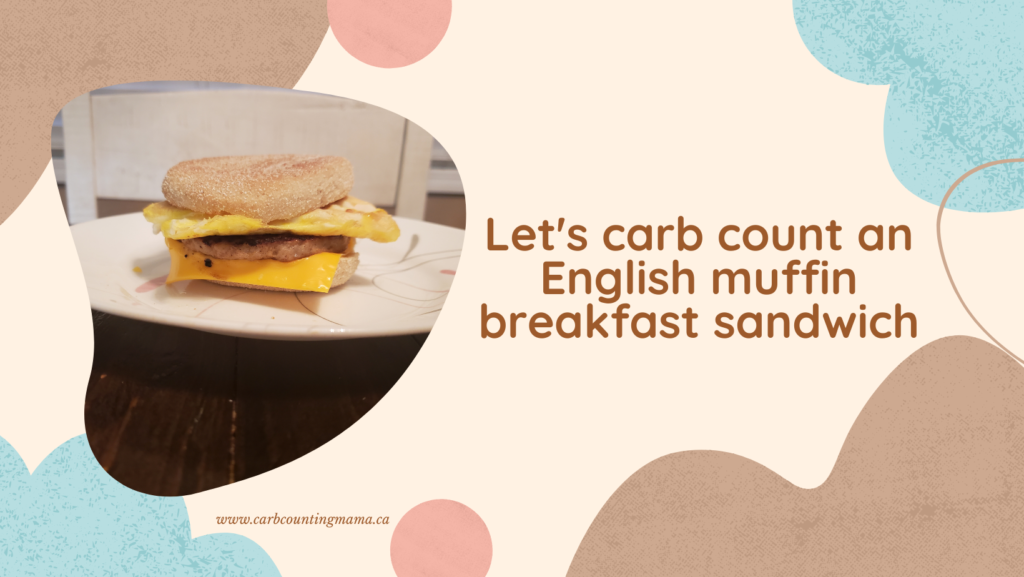

Here’s a simple breakfast sandwich and the nutrition labels for the four items in it (an English muffin, a sausage round, a singles cheese slice, and a fried egg). Let’s figure out the carb count!
The first label is for the slice of cheese. That has 3 g of carbs and 0 g of fiber. So, 3 net carbs. The second is for the English muffin which has 24 g of carbs and 1 g of fiber. That makes 26 g of net carbs for the cheese and English muffin. We subtracted the 1 g of fiber.
Next, we’ll add the egg. Many people count eggs as zero, which is fine for most carb ratios. But some people need a carb ratio of 1:2 or 1:5. These ratios will be affected by even 1 gram of carbs, so be aware that eggs aren’t actually zero.
This, along with the sausage (which is actually zero grams of carbs) gives us a total of 27 net carbs for the entire sandwich.
You’d then take that 27 grams and put it in your carb ratio. Everyone’s carb ratio is different and many people even have varying carb ratios throughout the day.
If your carb ratio is 1:15, for instance, that means you need one unit of insulin for every 15 grams of carbs. So, you’d divide 27 by 15 to get an insulin amount of 1.8 units.
If you’re using an insulin pump, you can leave it at that. If you’re doing MDI (multiple daily injections), you’ll need to round up or down to the nearest unit or half unit (depending on the pens/syringes that you use) to get a final insulin bolus amount.
Nutrition Labels with Odd Portions
Unfortunately, many nutrition labels aren’t that straightforward.
Have you ever looked at the portion size on a box of spaghetti? I have, and it’s confusing. Very few give an easy measurement.
Most say something like “per 1/8 package” or “per 100g”.
These are not only difficult to measure, but they can also be ambiguous. Per 100g cooked or raw? That will make a huge difference to the carb count.
Aside from pasta, some other big offenders are:
- Frozen pizza (who cuts a pizza into fifths??)
- Cupcake or brownie mix (per 1/4 cup dry mix… seriously?)
- Rice (1/3 of the bag is a serving!?)
- Cereal, canned soup, and trail mix (Remember, the carb count is an AVERAGE serving. Because there are many ingredients in these items, what is actually in a serving could vary quite a bit.)
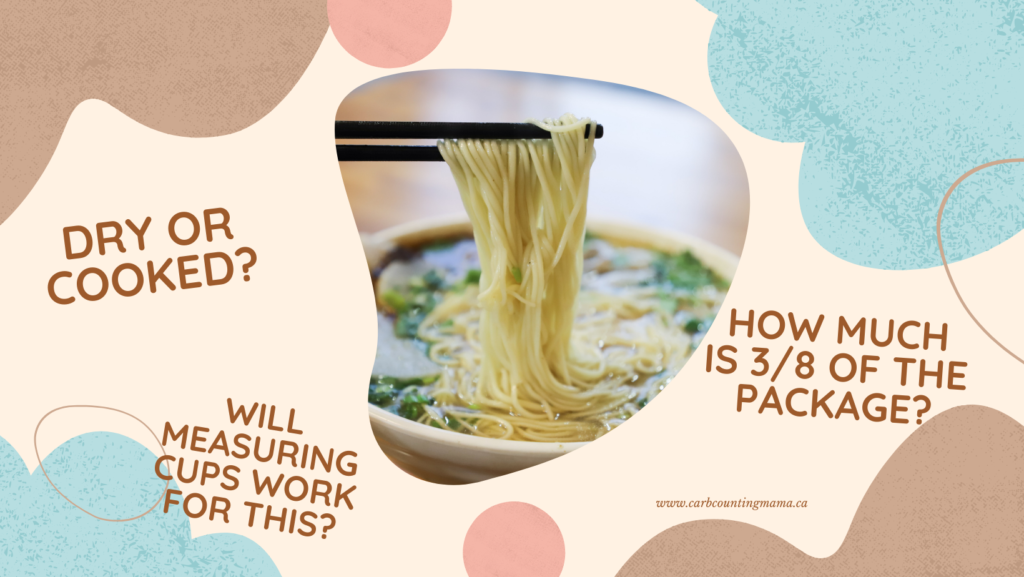
Tackling these nutrition labels can be a bit more complex. It really helps to have a food scale, know your T1D math equations, and know how to use carb factors. Check out this article about confusing nutrition labels for more information about navigating carb counting with more difficult nutritional information!!
Happy Carb Counting!!
~ Leah
For more tips and stories about T1D, join the Carb Counting Mama email list, and make sure to head over to the Carb Counting Mama Facebook page and “like” it.
Great post with good info! In the US the FDA is issuing new label guidelines that will include added sugars (although like you said, we still go by total carb)and hopefully more appropriate portions. Hope they change the pizza size, you’re right, no one cuts pizza into 1/5ths!
Thank you Sylvia! I have heard about the new guidelines, it’ll be interesting to see how much they actually change. Hopefully it’s for the better!